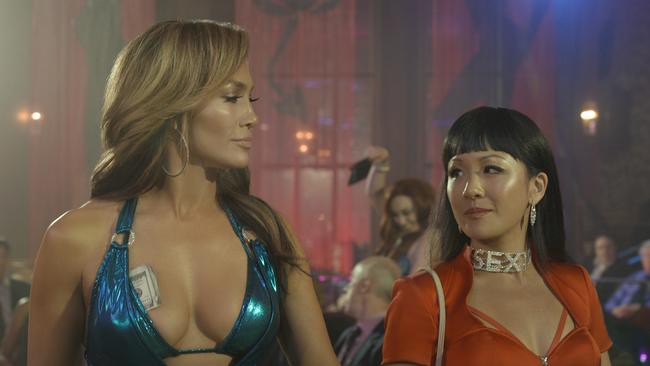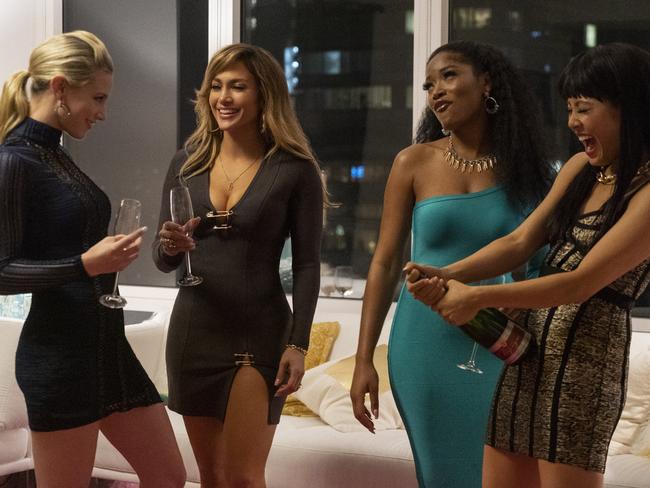Jennifer Lopez takes control as power stripper in Hustlers
When you see the world as one big strip club, every client is a potential mark.

Right from the start, Janet Jackson tells us what’s going on. “This is a story about control,” are the opening words of the spoken introduction to the song that propels us into the world of Hustlers.
It’s a sharp and exhilarating tale of women and friendship and money and power, based on the true story of a group of women who worked at a New York strip club and figured out a way of fleecing selected clients.
For writer-director Lorene Scafaria, it was the only way to begin. That song cue was always in the script.
“It speaks to the theme of the movie, and all the ways in which its central characters feel a sense of control or the lack of it in every aspect of their lives. But it’s always a complicated, contradictory matter,” Scafaria says.
“There’s also the feeling that just because we’re empowered doesn’t mean we’re in control. And that money still rules the world.”
So to the sound of Jackson’s Control, a tracking shot follows newcomer Destiny (Constance Wu) from the dressing room to the stage and the pole on her first night at work in 2007 at a men’s club with a Wall Street clientele. As it turns out, this scene has a context: it’s a recollection, a story she’s telling about how she met her friend and mentor, Ramona (Jennifer Lopez), and where that friendship led.
Hustlers is about control, but it is also about point of view. It is based on events set out in a 2015 article for New York magazine by Jennifer Pressler about a scam carried out several years earlier.
Control, once again, is key. Scafaria shows the story unfolding as it’s being told to a journalist (Julia Stiles). The point of view is Destiny’s, Scafaria says. “(She is) looking back on this time in her life, and being reflective about it, but also still trying to control the narrative and telling it the way that she wants.”
So it’s through her eyes that we see the entrance of Ramona, dominating the stage, the club, the clientele. Later that evening the two meet. The first scene that Scafaria wrote was this one, in which Destiny introduces herself to Ramona, who is out on the rooftop, wearing a vast fur coat and smoking a cigarette. It’s a cold night and Ramona sweeps Destiny up in the fur, in an embrace both intimate and protective.
Scafaria had a story to tell about a scam, but she also wanted to create a sense of the world her characters inhabited, to evoke what it was like at different times — working in the club, enduring what it entailed and choosing the ways in which they spent what they earned. “I wanted to show the visceral part of it,” she says, “and what a day in the life is like, and a night in the life. Some people get into it to pay the bills, and some people get into it because they’re drawn to one aspect of it. It’s a complicated job, but it is still a job at the same time.
“The truth is, I think, that the difference between a good and a bad day is how much you go home with at the end of it.”
In 2008, when the global financial crisis hits, business at the club declines. Destiny takes a break, then returns a few years later and it has all gone downhill.
Eventually Ramona comes up with a scheme that involves not only cajoling and working on the regulars to throw their money around but also slipping their targets a drug cocktail, then charging their credit cards. The next day their victims won’t remember or can’t own up to what happened — for some, it’s hard to admit that a woman has scammed them.
“I really wanted to stay in their (the women’s) point of view,” Scafaria says. “That was really what I was so drawn to.” The film is a crime drama and a friendship story, she says, and it reflects its time and place and the economic circumstances. “But as far as the world of the strip clubs goes, I felt like we’ve seen scenes and strip clubs and so many movies and TV shows, but never from the dancers’ point of view.” She wanted to “show how mundane it can be, and to show nudity as it really is, I wanted this collective experience, and yet this very individual experience that Destiny has.
“There was so much to explore: in another world I would have just stayed in that club environment and told that story. But there are so many (stories) in that world to tell, hopefully more will be.”
A strong ensemble cast includes Keke Palmer and Lili Reinhart as Ramona and Destiny’s main co-conspirators; rappers Cardi B and Lizzo play dancers at the club.

Music plays a memorable part in Hustlers. Some songs were incorporated in the script early on, and sometimes Scafaria shot to them before she had the rights. One was a sequence with Scott Walker singing Jacques Brel’s Next over it (“it’s so strange and funny and obviously tragic, and his voice and Brel’s lyrics captured that sequence so perfectly”), another a scene in which Ramona walks down the street to the ATM to the sound of Lorde’s Royals. “I couldn’t imagine that with anything else,” Scafaria says.
“Overall, there was a certain sound to the movie. It was almost like a musical. The Chopin pieces were chosen ahead of time, and I had edited a lot of footage of strippers and striptease to Chopin as a kind of proof of concept. And my editor Kayla (Empter) was also incredible at finding pieces for me.”
For Ramona’s entrance and pole dance, Scafaria used Fiona Apple’s Criminal. “That was one of those songs that was not thought of ahead of time because that scene was not really thought of,” Scafaria says.
“Only when you get Jennifer Lopez on board, you get to step it out and turn it into the kind of number that it was ultimately.”
Lopez studied and prepared for the sequence, and Scafaria suggested this song to her. “She loved it, and with her choreographer came up with this routine that my (director of photography) and I only saw two weeks before we shot it.
“So now we get to see Destiny seeing Ramona and it really becomes love at first sight. It’s a moment for Ramona to enter the ring like a boxer, and for us to highlight the athleticism of it, the strength and the power of the performance.
“And there’s that theme of control again. That’s the scene where I think Ramona is in control of the camera — where the camera goes and when we cut and then cut back. And the point of view of Ramona, feeling the power on stage. We’re also like the crowd in the club itself. We, the audience, are being hustled by Ramona.”
After all, in Ramona’s words, that’s the way the world works. “This city,” she says, “this whole country, is a strip club. You’ve got people tossing the money, and people doing the dance.”
